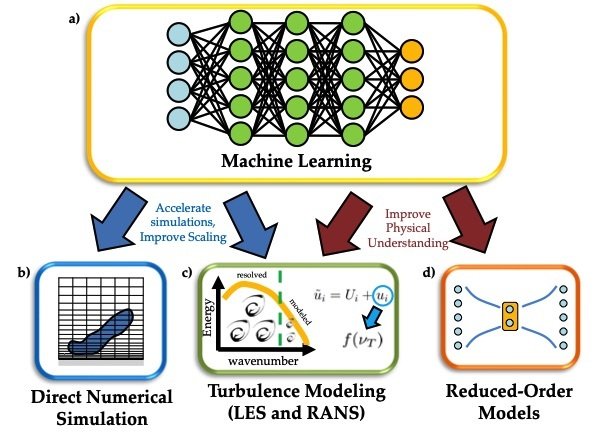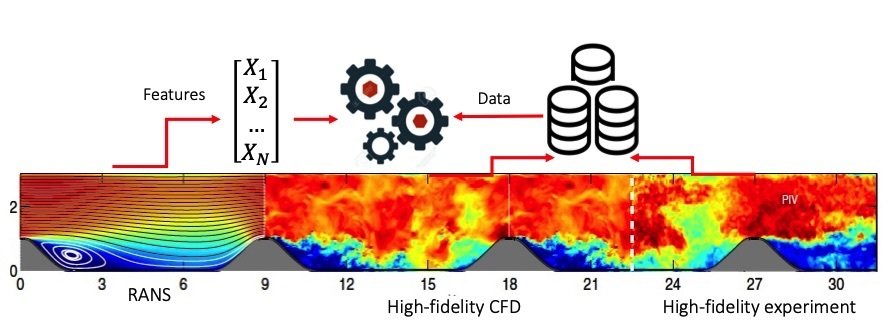Machine Learning for Fluid Dynamics
Objectives:
- Spreading knowledge and fostering collaborations on machine learning (ML) techniques for flow modelling, simulation, and analysis
- Contribute to the collection, description, and maintenance of databases for ML model training
- Provide a platform to exchange open-source routines and datasets
- Establish suitable test cases for the benchmarking of ML methods
- Support the organization of thematic workshops
- Organize schools and courses for graduate students and industry practitioners

Figure 1: Summary of some of the most relevant areas where ML can enhance CFD.
From Vinuesa & Brunton,
Nature Computational Science, 2022.

Figure 2: Simplified workflow of Machine-Learning-Enhanced turbulence modelling.
Scientific/technical focus:
- Data-driven/data-augmented models for different physical phenomena in fluid dynamics as, e.g., turbulence modeling
- ML-assisted reduced-order modelling or surrogate modelling of flows, feature detection, signal processing
- ML-based flow control and optimization
- Super-resolution reconstruction of flow fields
- Quantification of model uncertainties
Motivation & Landscape:
The application of ML methods to Fluid Mechanics has been growing exponentially during the last decade or less, as testified by the increasing number of review articles and the organization of Symposia and dedicated sessions in both Fluid Mechanics and ML conferences. Despite this, ML learning for fluid dynamics is still in its infancy, and the encouraging results achieved up to now, generally restricted to academic problems characterized by simple geometries and flow physics, and by the availability of abundant, complete and accurate data, is far from being satisfactory in view of the deployment of ML methods to realistic flow problems. On the other hand, fine-detail understanding, accurate modelling, and reliable prediction of complex flows remain a significant challenge for both fundamental and applied Fluid Dynamics. The development of a new generation of ML-assisted methods and models for the simulation and modelling of different kinds of flows is a key enabler toward improved predictive capabilities, with impact on the design of more efficient and environmentally friendly fluid systems.
Applications include Aerospace, Automotive and Energy conversion systems, as well as biomedical devices.
Outline plans:
The main activities will be the exchange of AI/ML methodologies between European research and industrial groups; development and maintenance of a web platform referencing databases for the training of ML methods, test cases (for verification, validation and benchmarking of ML-assisted models),courses/workshops/conferences.
For activities concerning turbulence modelling, the SIG will work in close collaboration with the NASA Turbulence Model Benchmarking Group (https://turbmodels.larc.nasa.gov/tmbwg.html), which focuses on turbulence model development, implementation, application, and validation/verification and involves members from NASA, AIAA, and academic research institutions.
The SIG will also promote, at least once every two years, thematic workshops, and symposia.
Finally, the SIG may contribute to the dissemination of ML into the Fluid Mechanics community through the Wiki and through the organization of thematic Schools. The above events will also provide a platform in which developers of ML methodologies could profitably exchange and collaborate with researchers in Fluid Dynamics, who use or wish to use these methodologies.
Short description:
The fine-detail understanding, accurate modelling, and reliable prediction of complex flows represent a significant challenge for both fundamental and applied Fluid Dynamics. The exponential growth of Machine Learning techniques, supported by the increased availability of high-fidelity flow data, is expected to play a game-changing role for the development of a new generation of ML-assisted methods and models in Fluid Dynamics. The latter are expected to ensure improved predictive capabilities at lower computational cost, with impact on the design of more efficient and environmentally friendly fluid systems.
The SIG covers all activities concerning the development and application of ML techniques to the modelling, simulation, and analysis of flows. The latter include:
- Data-driven/data-augmented models for different physical phenomena in fluid dynamics, as, e.g., turbulence modeling
- ML-assisted reduced-order or surrogate modelling of complex flows, feature detection, signal processing
- ML-based flow control and optimization
- Super-resolution reconstruction of flow fields
- Quantification of model uncertainties
Applications include Aerospace, Automotive and Energy conversion systems, as well as biomedical devices. The SIG will organize thematic workshops and schools to foster scientific activities and the training of graduate students and industry practitioners.
We look forward to sharing information on datasets, test cases, open-source software, and other relevant information.
Related Events
3rd ERCOFTAC Workshop - Machine Learning for Fluid Dynamics
4th - 6th March 2026 Amsterdam, The Netherlands CHAIRS: Benjamin Sanderse (CWI) & Richard Dwight (TU Delft) Please save the date and spread the word! More information to be provided in due course.
4 Mar 2026EuroMech Colloquium on Data-Driven Fluid Dynamics and 2nd ERCOFTAC Workshop on Machine Learning for Fluid Dynamics
EuroMech Colloquium on Data-Driven Fluid Dynamics and 2nd ERCOFTAC Workshop on Machine Learning for Fluid Dynamics 2nd - 4th April 2025 Mary Ward House, 5-7 Tavistock Place, London, WC1H 9SN, United Kingdom This two and half day long event will be the second edition of the
2 Apr 2025Machine Learning for Fluid Dynamics
Workshop on 6th - 8th March 2024 Sorbonne University, Paris, France This two and half day long workshop will be the first edition of a “Machine Learning for Fluid Dynamics” workshop in relation with the SIG54 activities. Location: Pierre and Marie Curie (Jussieu) Campus of
6 Mar 2024Related News
3rd ERCOFTAC Workshop - Machine Learning for Fluid Dynamics - Date Announced: 4th - 6th March 2026
4th - 6th March 2026 Amsterdam, The Netherlands CHAIRS: Benjamin Sanderse (CWI) & Richard Dwight (TU Delft) Please save the date and spread the word! More information to be provided in due course.
9 Apr 2025EuroMech Colloquium on Data-Driven Fluid Dynamics and 2nd ERCOFTAC Workshop on Machine Learning for Fluid Dynamics
We are thrilled to invite you to: the EuroMech Colloquium on Data-Driven Fluid Dynamics and the 2nd ERCOFTAC Workshop on Machine Learning for Fluid Dynamics, taking place from April 2-4, 2025, in London, UK . This joint event will bring together minds from Fluid Mechanics, Applied Mathematics, and
9 Oct 2024Machine Learning for Fluid Dynamics - Workshop Overview
The first ERCOFTAC Workshop on Machine Learning for Fluid Dynamics at the Sorbonne University in Paris was a great success! The event took place on the 6th - 7th March 2024. “ML4FUID workshop is a magnificent festival which gathers plenty of experts to share ideas and experience on how to
21 Mar 2024